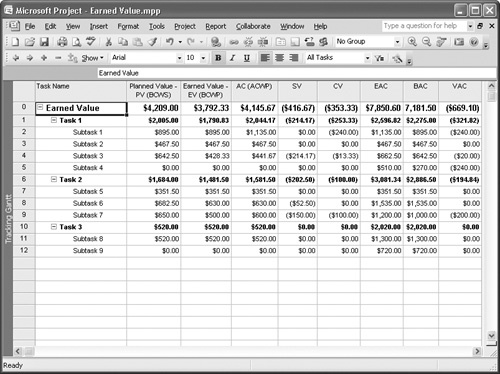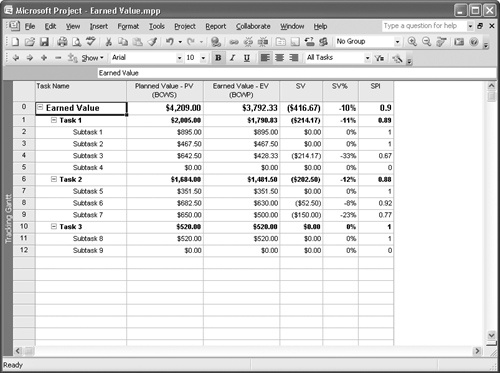Project costs and budget are always a consideration, but they take on a particularly important meaning when you discuss your project with management. Many project managers use earned value management as a technique to assess a project’s schedule and cost status based on resource expenditures. Using earned value management, project managers can identify potential problems because it goes beyond comparing budget amounts to actual amounts. It helps you assess and predict your project’s schedule and expenditures based on what has happened to date in your project.
For example, suppose that you find that you’ve spent $75,000 after four months of project work, but according to your project plan, you shouldn’t have spent that much until completing six months of your plan. Although you appear to be over budget, you also need to consider where you are in your schedule before making the determination. For example, it’s possible that you might have performed more work than you scheduled in the first four months of the project. If you paid the amount you predicted for that work, you’re actually on budget and ahead of schedule. It’s also possible that you performed the amount of work you predicted for the first four months of the project, but you paid more than you estimated; in this case, you’re on schedule but over budget.
Earned value management techniques aren’t foolproof, but by using them you can make a fairly accurate assessment of your current status.
Project automatically calculates values for a variety of earned value fields, eliminating the need for you to do the math. Three fields form the foundation of earned value management calculations:
Planned Value (PV). Also known as Budgeted Cost of Work Scheduled (BCWS), this field reflects the budgeted cost of individual tasks based on the resources and fixed costs that you assign to the tasks when you schedule them.
Earned Value (EV). Also known as Budgeted Cost of Work Performed (BCWP), this field indicates how much of a task’s budget should have been spent up to the project status date or today given the actual duration of the task. For example, suppose that you have a task budgeted at $1,000 and work has been performed for one day. You find that after one day 25 percent of the work has been completed. The BCWP for the task at this point is $250.
Actual Cost (AC). Also known as Actual Cost of Work Performed (ACWP), this field measures the actual cost incurred to complete a task. Before you complete the task, ACWP represents the actual costs for work performed on the task through the project’s status date.
11.1 describes the earned value fields Project calculates.
Table 11.1. Earned Value Fields in Project
FIELD | DESCRIPTION | MATHEMATICAL FORMULA THAT PROJECT USES | TYPES OF PROJECT FIELDS |
|---|---|---|---|
SV | Schedule Variance represents the cost difference between current progress and the baseline plan | BCWP - BCWS | Task, resource, assignment, and timephased |
CV | Cost Variance represents the cost difference between actual costs and planned costs at the current level of completion | BCWP - ACWP | Task, resource, assignment, and timephased |
BAC | Budgeted At Completion represents the baseline cost | The sum of planned fixed costs + planned costs for all assigned resources | Task, resource, assignment, and timephased |
EAC | Estimate At Completion shows the planned costs based on costs that are already incurred plus additional planned costs | ACWP + (BAC - BCWP) / CPI | Task |
VAC | Variance At Completion represents the variance between the baseline cost and the combination of actual costs plus planned costs for a task | BAC - (ACWP + BCWP) | Task, resource, and assignment |
Cost Performance Index | BCWP / ACWP | Timephased | |
SPI | Schedule Performance Index | BCWP / BCWS | Timephased |
CV% | Cost Variance Percentage | (CV / BCWP) * 100 | Timephased |
SV% | Schedule Variance Percentage | (SV / BCWS) * 100 | Timephased |
TCPI | To Complete Performance Index. The TCPI value that is presented in Project reflects one of the two variations of the TCPI, TCPIBAC. | (BAC - BCWP) / (BAC - ACWP) | Task |
Physical % Complete | Physical Percentage Complete represents your estimate of the progress of a task, regardless of actual work or time. Physical % Complete can be used as the basis for calculating earned value fields, effectively allowing the project manager to set the completion percentage rather than using the Project calculation based on actual work or duration. With typical settings, Project assumes that when 60% of the resources are used, 60% of the task is done. | Roll up BCWP on subtasks to BCWP on associated summary tasks | Task |
While all of the earned value fields have meaning, the ones that are probably of greatest interest to you are SV and CV, since they are the ones that tell you how far off target your project is. When you review your earned value fields, you can interpret the SV and CV values in the following way:
A negative dollar amount in either field means you’re behind schedule or over budget.
A zero dollar amount in either field means you’re on schedule or on budget.
A positive dollar amount in either field means you’re ahead of schedule or under budget.
Cost variances appear when your costs for resources turn out to be higher or lower than you planned. Schedule variances appear when the work on your schedule is running ahead of or behind schedule. Both cost and schedule variances can appear if the tasks in your project require more or less work than you planned or the people performing the work are working more or less efficiently than you planned.
Project contains four earned value tables that you can use to compare your expected costs with your actual costs and evaluate the relationship between work and costs.
You can compare the relationship between work and costs for tasks to estimate future budget needs using the Earned Value table for tasks (see 11-4).
Project calculates all of the fields on this sheet except BAC; you can type values into the BAC field to change information in the table.
The Earned Value table for resources (see 11-5) displays the same fields as the Earned Value table for tasks; you can use this table to help you compare the relationship between planned and earned values for resources.
The Earned Value Cost Indicators table displays only cost-related earned value fields so that you can compare the various cost factors related to tasks in your project (see 11-6). To focus on the effects of scheduling variances on the cost of your project, use the Earned Value Schedule Indicators table for tasks (see 11-7), which displays only schedule-related earned value fields.
To display the Earned Value table for tasks, the Earned Value Cost Indicators table, or the Earned Value Schedule Indicators table for tasks, first display any task-oriented view. Then right-click the Select All button, and click More Tables on the shortcut menu that appears. When Project displays the More Tables dialog box, click the appropriate table and click Apply.
To display the Earned Value table for resources, start in any resource-oriented view and follow the same procedures.
Although their names are similar, % Complete and Physical % Complete aren’t related fields. The information that appears in Project’s % Complete field is the percentage of a task that is complete, just as you’d expect. If you don’t enter a value in the % Complete field, Project calculates it for you by dividing actual task duration by total duration. Project uses the % Complete field to calculate the budgeted cost of work performed (BCWP).
Physical % Complete has no connection to duration information; instead, you use this field to enter your estimate of where a task stands. You can use the Physical % Complete field as an alternative way to calculate BCWP when the % Complete value does not accurately represent the real work performed on a task.
You can set Physical % Complete as the default earned value calculation method for all new tasks in your project or you can calculate Physical % Complete for some but not all tasks.
You use the Calculation tab of the Options dialog box to select an earned value method. On the Tools menu, click Options, and click the Calculation tab. Then click the Earned Value button to display the Earned Value dialog box (see 11-8).
In the Earned Value dialog box, in the Default Task Earned Value Method list, click Physical % Complete. Then in the Baseline For Earned Value Calculations list, click a baseline. Click Close and then click OK.
Note
You can clear baselines, but don’t worry about losing Physical % Complete values. If you clear a baseline after entering Physical % Complete values for it, Project doesn’t clear the Physical % Complete values.
To calculate BCWP for some but not all tasks, display a task-oriented view and select the task(s) for which you want to set the earned value calculation method to Physical % Complete. Click the Task Information button on the Standard toolbar to display the Task Information dialog box. Click the Advanced tab, and in the Earned Value Method list, click Physical % Complete (see 11-9).






